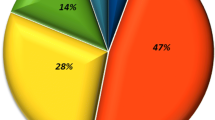Abstract
The 4th nationwide epidemiological survey on Behçet disease (BD), which included all patients with BD at 1,200 hospitals selected at random from 10,081 hospitals in Japan, was carried out by the BD Research Committee of the Ministry of Health and Welfare in 1991 to examine the epidemiological features of BD in Japan by comparing with previous surveys. 3,938 patients from these hospitals were examined by the Japanese diagnostic criteria of BD (JCBD) revised in 1987 and the International criteria for classification of BD (ICBD). Among these 3,938 patients, 622 patients were only suspected of having BD or clinical signs of the disease were unknown, and most of these patients were incompatible with the ICBD. So these patients were excluded from the study of epidemiological features. The average patients age has risen 7–8 years over the last 20 years and the average age of onset in both sexes increased by about 3 years from 1972 to 1991. While a decrease in the sex ratio was seen in the complete-type and the incomplete-type BD without ocular symptoms, a sustained high sex ratio was shown in incomplete-type BD with ocular symptoms. The positive rate of HLA-B51 antigen was 54.9% (men: 56.9%, women: 52.2%) significantly higher than die 15–16% in healthy subjects but it might have been gradually decreasing. Also the clinical course of BD has become too mild for prognosis. According to diese epidemiological features of BD, the clinical manifestation of BD in Japan might have become the Western type of BD.
Similar content being viewed by others
References
Editorial Board. Behçet’s Disease. The Lancet, 1989: 1 (8641): 761–2
Ohno. S. Behçet’s disease in the world, ed.Inaba. G, Tokyo; University of Tokyo Press, 1981: 181–6
Masuda K, Inaba G, Mizushima H. A Nationwide Survey of Behçet’s Disease in Japan: Clinical Survey. Jap J Ophthalmol, 1975; 19:278–85
Maeda K, Nakae K. Recent Epidemiological Review on Behçet’s Disease. Asian Med J 1977; 20: 568–82
Nakae K, Maeda K, Agata T. Late trend of Behçet disease in Japan, 1979 reports of Japanese Behçet’s disease Research committee, Ministry of Health and Welfare, Japan. 1980: 89- 93 (in Japanese)
Nakae K, Agata T, Maeda K. Late trend of epidemiological features on Behçet disease, 1984 reports of Japanese Behçet’s disease Research committee, Ministry of Health and Welfare, Japan. 1985: 65–9 (in Japanese)
Nakae K, Masaki F, Hashimoto T. An epidemiological study on risk factors of Behçet’s disease in Japan. Recent progress of epidemiologic study of intractable disease in Japan, ed. by Yanagawa H et al.,The Epidemiology of Intractable Disease Research Committee of Japan, 1992: 175-80
Nakae K, Furusawa F, Hashimoto T, Inaba G, Mochizuki M, Sakane T. The 4th nationwide epidemiological surveys on Behçet’s disease in Japan:The rate of prevalence and incidence, 1992 reports of Japanese Behçet’s disease Research committee, Ministry of Health and Welfare, Japan. 1993: 63–9 (in Japanese)
Sakane T, Yamashita N. Diagnosis for Behçet’s disease, Japan. J. Clinical and Experimental Med, 1993; 164 (1): 3–7 (in Japanese)
International Study Group for Behçet’s Disease. Evaluation of diagnostic (“classification”) criteria in Behçet’s disease: Toward internationally agreed criteria, Behçet’s disease: basic and clinical aspect/edited by J. Desmond O’Duffy and Emre Kokmen. New York: M. Dekker, 1991: 11–39
Nishiyama N, Nakae K, Hashimoto T, Inaba G, Sakane T. Recent epidemiological features of familial Behçet’s disease in Japan. Asian Med J 1996; 39(9): 495–501
Plotkin G.R, Calabro J.J, O’Duffy J.D. Behçet’s disease,a contemporary synopsis, New York: Futura, 1998
Mizuki N, Ohno S, Tanaka H. et al. Association of HLA- B51 and lack of association of class II alleles with Behçet’s disease.Tissue Antigens 1992; 40: 22–30
Brautbar C, Chajek T, Ben-Tuvia S, Lamm L, Cohen T. A genetic study of Behçet’s disease in Israel. Tissue Antigens 1978; 11: 113–20
Balboni A, Pivetti-Peezzi P, Orlando P, et al. Serological and molecular HLA typing in Italian Behçet’s patients: Significant association of B51-DR5-DQw3 haplotype. Tissue Antigens 1992; 39: 141–3
Mizuki N, Inoko H, Ando H. et al. Behçet’s disease associated with one of the HLA-B51 subantigens, HLA- B*5101.Am J Ophthalmol. 1993; 116: 406–9
Takeno M, Kariyone A, Yamashita N. et al. Excessive function of peripheral blood neutrophils from patients with Behçet’s disease and HLA-B51 transgenic mice, Arthritis and Rheumatism 1995; 38(3): 426–33
O’Duffy JD. Behçet’s disease: Current opinion in Rheumatology 1994; 6: 39–43
Mason RM, Barnes CG. Behçet’s syndrome with arthritis. Ann Rheum Dis 1969; 28: 95–103
O’Duffy JD. Criteria proposes pour le diagnostic de la maladie de Behçet et notes therapeutiques. Rev Med 1974; 36: 2371–9
Zhang X-Q. Our diagnostic criteria for Behçet’s disease. Chin J Intern Med 1980; 19: 15 (in Chinese)
Dilsen N, Konice M, Aral O. Our diagnostic criteria for Behçet’s disease — an overview. In. Lehner T, Barnes CG, eds. Recent Advances in Behçet’s Disease. Royal Society of Medicine Services. Int Congr Sympos Series 1986; 103: 177- 80
Mizushima Y. Recent research into Behçet’s disease in Japan, Int. J. Tiss. Reac. 1988; 10(2): 59–65
Hasen A, Fortune F, Wilson A. et al. Role of γ δ T cells in pathogenesis and diagnosis of Behçet’s disease, Lancet 1996; 347: 789–94
Inaba G. Pseudo-Behçet’s syndrome, a problem for accurate diagnosis, Japan J Clinical and Experimental Med 1993; 164(1): 26–9 (in Japanese)
Author information
Authors and Affiliations
Corresponding author
Rights and permissions
About this article
Cite this article
Nishiyama, M., Nakae, K., Yukawa, S. et al. A study of comparison between the nationwide epidemiological survey in 1991 and previous surveys on behçet’s disease in Japan. Environ Health Prev Med 4, 130–134 (1999). https://doi.org/10.1007/BF02932268
Received:
Accepted:
Issue Date:
DOI: https://doi.org/10.1007/BF02932268




